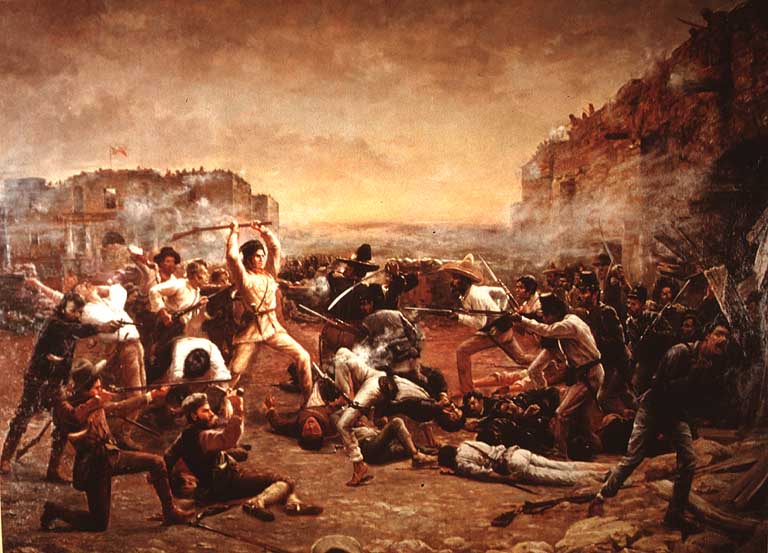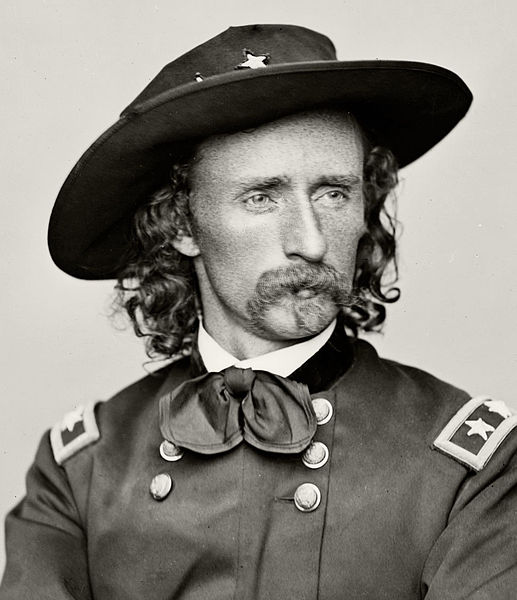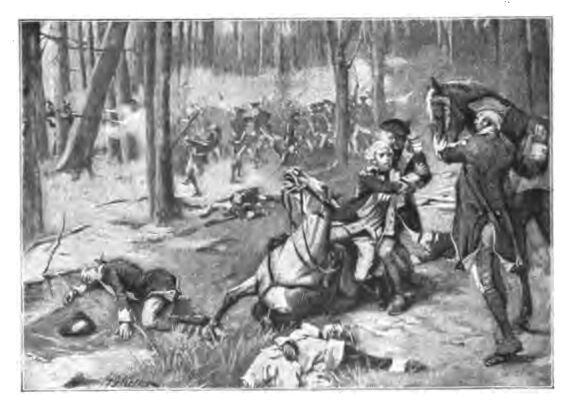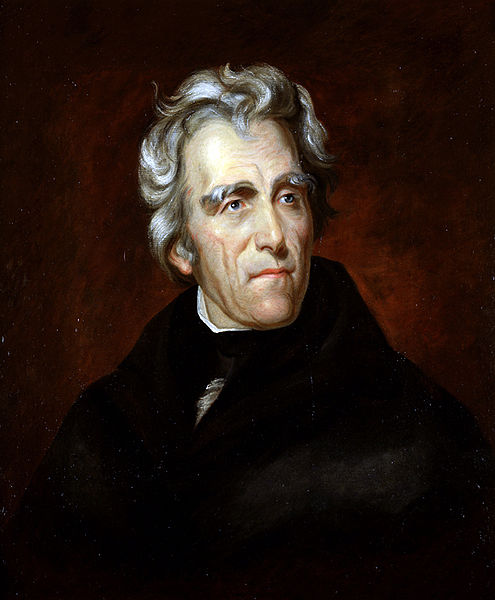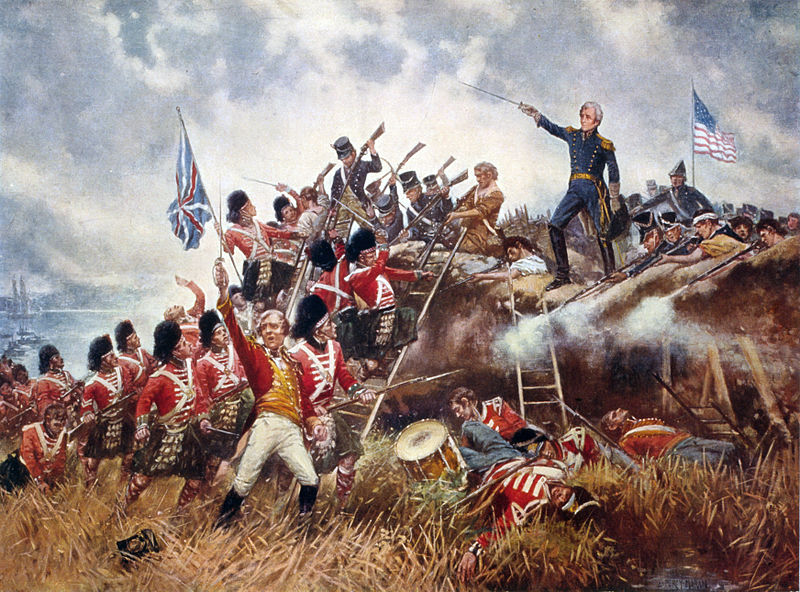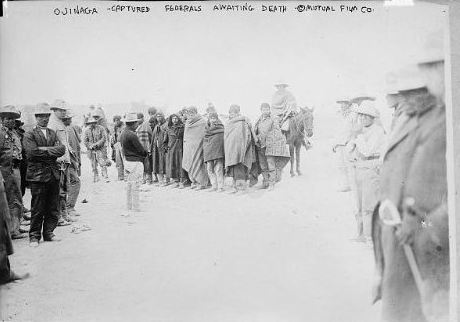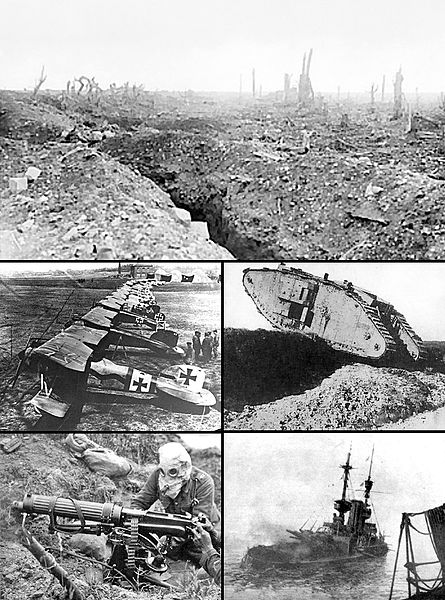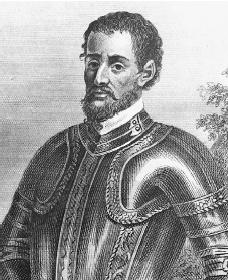Outside of the Civil War, there have been very few deadly battles on American soil. There were plenty of skirmishes in the United States during the American Revolution and the War of 1812, but these battles resulted in only 10,000 total combat deaths. While the United States lost over half a million soldiers in the two World Wars, almost all of these deaths occurred on foreign soil. Compared to wars fought in other nations—Russia lost some 20 million on its home turf in World War 2—the geographic United States has seen very few deadly battles.
To prove this point, think of some famous battles in U.S. history that you may know. Go ahead, take a few seconds.
Unless you thought of only Civil War engagements, you probably came up with a battle that saw less than 1,000 deaths. For example, in the deadliest battle in the American Revolution, the Battle of Bunker Hill, only 350 men lost their lives. About 500 men died in The Battle of New Orleans, the War of 1812’s most famous fight. Even well known battles fought in areas that were not yet part of the United States had few fatalities. Seven hundred men died at the Alamo, for example. Again, compared to foreign battles, these numbers are insignificant.
Now there were plenty of famous deadly battles during the Civil War: eight thousand men died at Gettysburg, 5,000 at Vicksburg, 4,000 at Antietam, and 3,500 at Shiloh. There’s no denying that the Civil War saw the most deadly fighting on American soil, but outside of this conflict, most people can’t name a major battle on U.S. soil that saw high casualties.
That’s not because these battles didn’t happen. It’s just that most people have never heard of them. Although the geographic U.S. has seen fewer combat deaths than other nations, there were a handful of deadly battles in American history outside of the Civil War. Here are those battles.
5. The Battle of Wabash
When most people think of America’s Indian wars, they envision well-armed whites using technology and superior numbers to push Indians off their land. Rightly so, as more often than not, Anglos defeated their Indian counterparts owing to their better firearms. Americans, however, weren’t always the victors when fighting Indians, as George Armstrong Custer discovered at the Battle of the Little Bighorn. In this most famous Indian victory, Lakota and Cheyenne warriors overwhelmed Custer’s Cavalry Regiment and killed some 250 men.
Indians killed three times that number of U.S. soldiers at the Battle of Wabash.
In 1791, settlers from the United States began moving on to Indian lands in the area of present-day Indiana. Unwilling to give up their land without a fight, the Indians attacked the newcomers, who responded by petitioning the new U.S. government for protection. George Washington answered the settler’s request by dispatching the entire U.S. military to Indiana Territory. He placed half this army and some militiamen, 1,100 total soldiers, under the command of General Arthur St. Clair.
Like many officers of the time, St. Clair underestimated Indians, believing them incapable of advanced combat tactics. With this line of thinking, St. Clair arrived in Indiana in October 1791, ill prepared for long-term campaigning. He thought that he would suppress the Indian revolt in short order and report the news to Washington before winter set in. The general set up his camp without bothering to build defensive fortifications.
Word of St. Clair’s arrival reached the Indians, and, displaying the tactical sense that St. Clair thought them incapable of, they decided to attack their enemy while they still had the element of surprise. On November 4, 1791, 1,000 Indians descended on St. Clair and his men as they ate breakfast. When the Indians were within a close distance to the U.S. Army camp, they opened fire and rushed. Taken by complete surprise, the Americans were unable to get to their guns before the Indians had them surrounded. What followed was a massacre. The Indians pressed their advantage, engaging the soldiers in hand-to-hand combat. When the men of the U.S. army began to flee, Indians cut them down. St. Clair attempted to rally his soldiers, but had trouble doing so because the Indians shot three horses out from under him. Within three hours, the majority of the St. Clair’s army was dead. The Indians stuffed the fallen soldiers’ mouths with dirt, saying, in effect, “If you want land, here you go.”
How many people died?
650 Americans, 20 Indians
Half of the U.S. military died in the Battle of Wabash. Yes, half. In today’s numbers that would be the equivalent of a million American soldiers dying in a single battle. The Battle of Wabash was the U.S. Army’s biggest defeat at the hands of Indians, and it still holds the distinction of having the highest casualty rate in the history of the U.S. Army. Out of the 1,100 soldiers and militiamen at the battle, less than 60 escaped alive and unharmed.
Why you’ve never heard of it:
As could be expected, the U.S. government and St. Clair—who somehow managed to survive—tried to play down the incident. It worked. The press never reported on the extent of the army’s defeat, and the public, willing to trust George Washington’s leadership, never demanded it.
Another reason why the Indian victory has not become legend is that it didn’t change a whole lot. A year after St. Clair’s defeat, the U.S. army reorganized, returned to Indiana, defeated the Indians, and forced them west.
4. The Battle of Horseshoe Bend
Although Indians won the Battle of Wabash, they lost most battles with U.S. forces. The biggest American victory over Indians happened shortly after the United States entered the War of 1812. The War of 1812 was kind of a sequel to the American Revolution, Britain against the United States part two. It was also, however, a conflict between Indians and Americans, as many tribes used the chaos of the war to take back lost territory. One such tribe was the Creeks of the U.S. South. When America and Britain went to war, the Creeks took advantage of the situation by attacking U.S. forts across the American Southeast. During one such assault in 1813, the Creeks overran a garrison in Alabama and killed 500 American soldiers and civilians.
With the bulk of the U.S. army busy fighting Britain on the Canadian border, it was left to Tennessee militiamen to deal with the Creeks. Much of the time, militiamen were incompetent and useless in battle. This wasn’t the case with the 4,000 or so men from Tennessee. Future president and badass, Andrew Jackson led the militia, with fellow badasses Davy Crockett and Sam Houston serving at his side. Throughout 1813 and early 1814, this all-star militia assaulted the Creek army, eventually forcing 1,000 of the Indians to flee to a massive fort on a bend in the Tallapoosa River.
In what came to be known as the Battle of Horseshoe Bend, on March 27, 1814, the Tennesseans rushed the Creek fort, scaled its palisades, and started shooting Indians with their superior firearms. Overwhelmed, the Indians jumped over the fort’s rear wall into the Tallapoosa River. As the Creeks attempted to swim to the opposite bank, the Tennessee militia picked them off one by one, leaving almost 900 bodies to float downstream. The remaining Creeks surrendered and signed over 23 million acres of their land to Jackson
How many people died?
About 900 Creeks, 100 Americans and their Indian allies, Sam Houston’s dignity (An arrow hit near Sam’s crotch, leaving him to deal with a soupy, pus-like discharge for the rest of his life)
Why you’ve never heard of it:
The Battle of Horseshoe Bend is one of two examples of Jackson’s battlefield prowess in the War of 1812. He also defeated the British in the Battle of New Orleans. In an effort to conserve space, history books tend to focus on one battle or the other, rarely both. In most texts, the Battle of New Orleans receives preferential treatment because in it, Jackson’s forces routed a British army that had just arrived from Europe after fighting Napoleon’s armies. Defeating someone who fought against Napoleon sounds a lot better than beating up a numerically and technologically inferior enemy, then forcing them to sign over their land.
We may also not talk about the Battle of Horseshoe Bend because the Americans committed atrocities while fighting the Creeks. They cut off dead Creeks’ noses as trophies and sometimes raped Indian women. Also, shortly before the Battle of Horseshoe Bend, Jackson and his men burned down a Creek village with many Indians locked in their homes. While burning to death one Indian fell atop a sack of potatoes. As his fat melted off his skin in the fire, it dripped on to the potatoes and cooked them. Starving, Jackson and his men consumed the potatoes. Perhaps this cannibalism imagery is the reason why history books avoid Horseshoe Bend.
3. The Battle of Medina
Not all of these forgotten battles were fought between Americans and Indians. And some took place in areas that were not yet part of the United States. This was the case with the Battle of Medina, which occurred in 1813 in Texas, then a part of the Spanish Empire.
In 1810, Mexican revolutionaries began an eleven-year-long war for independence from Spain, a time filled with terrible, bloody battles. Liberty-loving rebels fought one such battle with pro-monarchy royalist forces on August 18, 1813, just outside of San Antonio, Texas, then a Spanish colony. Eighteen-hundred men made up the pro-Spain army. The insurgents numbered 1,400, Mexican revolutionaries and Anglos from the United States. The Americans had joined the Mexican rebels to get free land in Texas and, having fought in their own revolution twenty years before, for the opportunity to crotch-kick an oppressive colonial power.
Unfortunately for the Anglo-Mexican force, the only crotches that would be kicked that day were theirs. A cruel one-eyed Spanish general named Joaquín de Arredondo led the Spanish army. Arredondo had been fighting Mexican insurgents for the past two years, and as such, had learned their tactics. Knowing that the revolutionaries would be eager for battle, Arredondo sent 200 cavalry to lure the Anglo-Mexican force into a trap. He had his remaining men set up cannons and defensive works in preparation for the oncoming rebels.
Arredondo’s trap worked. When the American and Mexican revolutionaries saw the 200 cavalry, they thought they were the entire Spanish army and set off in pursuit. After an exhaustive march through the sandy Central Texas soil in the heat of summer, the revolutionaries finally caught up to the Spanish cavalry. Just as the rebels realized that they had stumbled into a trap, Arredondo ordered his entire 1,800-man army to fire. The insurgents’ only options were to collect bullets in their vital organs or run. Either choice resulted in death, as the Spanish chased down those fleeing the battle, cut them to pieces, and hanged the human meat from nearby trees.
How many people died?
1,300+ insurgents, 55 Spaniards
Why you’ve never heard of it:
It could be because Texas was not yet a part of the United States when the battle occurred. But as Texas wasn’t a part of the United States when the Alamo occurred—and everyone keeps talking about that thing—this explanation doesn’t make sense.
The likely reason that historians haven’t given the Battle of Medina as much attention as the Alamo, then, is that the Alamo had a happy ending (at least for Texans). Although every Alamo defender died, their sacrifice gave General Sam Houston time to gather enough men to defeat Mexico at the Battle of San Jacinto a few weeks later. The Battle of Medina, on the other hand, resulted in misery for almost all involved and the “bad guys” victory was long lasting. With the rebel army dead, Arredondo faced no opposition in Texas, and as such, he went on an eight-month-long reign of terror. Spanish soldiers executed hundreds of civilians in San Antonio, raped the wives of dead rebels, and stole from Texas residents at will. The War for Mexican Independence also went on for almost ten more years, a time in which the people of Texas lived in poverty and fear.
2. The Battle of Ojinaga
One hundred years after the Mexican War for Independence, from 1910-1920, revolution once again gripped Mexico. This time, rebels fought against the dictatorship of Mexican President Porfirio Diaz. Atrocities filled the war, which claimed over a million lives. One particularly horrendous battle took place in the border town of Ojinaga, Mexico, an important city because its location on the border of Texas meant that insurgents could obtain firearms from unscrupulous U.S. traders.
Knowing this, from January 3-12, 1914, Mexican revolutionary Francisco “Pancho” Villa led a 10,000-man army against some 4,000 pro-Diaz federalists holed up in Ojinaga. Villa’s superior numbers overwhelmed the federal troops and drove many across the Rio Grande into the United States. Unfortunately for those fleeing, when they got to the other side of the river, the U.S. Army took their weapons and kicked them back to Mexico. Weaponless, the federals stood no chance when they crossed the Rio Grande. Villa’s forces mowed them down. The New York Times estimated that 1,000 people died in this first phase of the Battle of Ojinaga. Journalists described local buzzards as “wheeling overhead lazily with their feasts of human flesh.”
Ojinaga changed hands four more times during the revolution, with piles of bodies accompanying each assault. To make matters worse, smallpox and influenza epidemics hit the town and without proper medical care due to the constant fighting, countless people succumbed to illness.
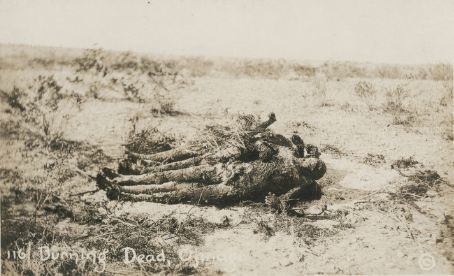
Dead bodies at Ojinaga. This was a postcard by the way. What is the guy sending this thing hoping to accomplish? What’s the poor mailman thinking? Does he even deliver it? So many questions.
The Battle of Ojinaga makes the list of United States battles because the fighting wasn’t confined to Mexico. In a few instances, when federas fled to the U.S., revolutionaries pursued them across the border. Rebels even made forays into the United States to raid, forcing the U.S. Army and the Texas Rangers to maintain a constant vigil along the Rio Grande.
How many people died?
Unknown, but likely thousands.
Why you’ve never heard of it:
Mexican historians haven’t paid much attention to the Battle of Ojinaga because, hey, they have enough bloody battles to worry about during the Mexican Revolution. Although the battle spilled onto American soil and thousands of refugees crossed the border into the United States, American historians ignore Ojinaga in favor of other early twentieth-century topics, like World War I and the Progressive Era.
Another reason that no one talks about the Battle of Ojinaga is that it has a cooler older brother that most historians choose to focus on: the Battle of Ciudad Juárez. The Battle of Juárez received more attention in the American press because reporters were able to watch the battle unfold from the safety of El Paso’s multi-storied hotels across the Rio Grande. No such buildings existed across from Ojinaga. Reporters also paid more attention to the Battle of Ciudad Juárez because it happened in 1911, when Americans were still interested in the Mexican Revolution. By 1914, when fighting began in Ojinaga, the American public had grown weary of war stories from south of the border and had instead turned their attention to Europe, where World War I was about to begin.
1. The Battle of Mabila
The final battle on this list happened over 200 years before the United States came into existence. Before Englishmen had even set foot on the North American continent. The Battle of Mabila was fought in central Alabama on October 18, 1540. Five-thousand American Indians from the village of Mabila and their allies from neighboring tribes sat on one side of the conflict. Hernando de Soto and 400 Spanish conquistadors opposed them.
De Soto and his men arrived in the American Southeast a year prior to the Battle of Mabila. Searching for gold and an Indian kingdom to conquer, De Soto and his men had cut a swath through present day Florida and Georgia, raping and pillaging any Indian village they encountered. Word of De Soto’s rampage reached Mabila, so the town’s chief decided to set a trap for the incoming Spaniards. He sent a messenger to invite De Soto to Mabila, with the promise that the Spaniard would receive hundreds of women when he arrived in the town. De Soto suspected a trap, but accepted the Mabila chief’s offer nonetheless.
The Spanish arrived at Mabila and entered the town’s high, palisaded walls. After enjoying a pleasant dance given by “marvelously beautiful women,” the Spaniards realized that they had been locked in the city’s gates and that 5,000 native warriors had them surrounded. Before De Soto could react, the Indians unleashed a volley of arrows and set fire to the village. Over twenty arrows struck De Soto, but none managed to penetrate his armor.
The Spanish quickly gathered their weapons, mounted their horses, and began exchanging blows with the attacking force. Fighting in disorganized bands and using stone weapons, many Indians fell to De Soto’s highly trained men with their horses and metal weapons. Seeing their relatives chopped to pieces with Spanish steel, the remaining Indians retreated, but cavalrymen cut them down before they could escape. As the battle subsided, De Soto saw only one Indian survivor. Realizing that escape was hopeless, the warrior removed the string from his bow and used it to hang himself from a tree.
How many people died?
An estimated 3,000+ Indians, 200 Spaniards.
Why you’ve never heard of it:
Historians used to think that Spanish conquistadors were liars. In report after report back to Spain in the 1500s, conquistadors like De Soto claimed that they had encountered tens of thousands of Indians in the Americas. These numbers seemed outlandish to historians because English sources rarely spoke of such large Indian populations and by the 18th century when Europeans returned to the Alabama area, there were no towns the size of Mabila. If there were no big cities in the 18th century, how could there be big cities in the 16th century?
Using archeological evidence, historians have recently concluded that the Americas had a much larger population than previously thought: an estimated 60 million people before Columbus’s arrival. Most of this population, however, died of European diseases in the late 16th century. By the time the English arrived, the Indians had already experienced an apocalypse. De Soto was one of the few Europeans to see Indian civilization before it collapsed.
If De Soto’s estimate of Indian deaths at the Battle of Mabila is accurate, as historians now believe it to be, it makes October 18, 1540 the deadliest single day of battle in American history. And most people have never heard of it.

